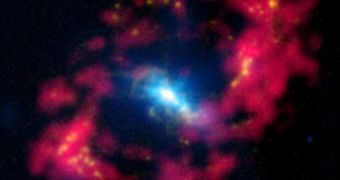Astronomers now believe that the cores of trillions of galaxies across the Universe are being powered by supermassive black hole. Recently, a team of experts proposed that these dark behemoths were produced by the collapse of massive stars made out of dark matter.
Unlike usual stars, which are made up of normal, baryonic matter, dark stars could have contained weirder elements, such as for supersymmetric particles. The scientific community now believes it has the necessary technology to try and detect signs of their existence.
Also worthy of mention is the fact that studies have demonstrated several times over that the gravitational pull of galaxies cannot be accounted for by the amount of normal mass they carry. As such, some other type of matter might be exerting its influence here.
Dark matter is the proposed explanation for the observed phenomena. It is currently believed to make up about 23 percent of the mass of the Universe, and to exist mostly in galactic halos. But there is no theoretical obstacle preventing it from enduring at the core of galaxies as well.
The associate director of the Michigan Center for Theoretical Physics, Katherine Freese, believes that the early stages of cosmic evolution were powered by dark matter instead of nuclear fusion.
She says that interactions between WIMP (Weakly Interacting Massive Particles) – which are their own antimatter particles – may have provided the necessary heat. At this point, WIMP are believed to be the particles making up dark matter.
Dark stars made of the stuff may have therefore existed in the early Universe. After the weird fuel was exhausted, these objects turned into heavy main sequence stars, which then went on to implode.
These powerful events gave birth to either neutron stars or black holes, depending on the size and mass of the original star. Over billions of years of cosmic evolution, these dark behemoths grew to the supermassive sizes we are observing today.
Freese and her team propose that the dark stars would have contained only 0.1 percent dark matter, and that the surface temperatures of these objects may have been less than 10,000 degrees Kelvin, Daily Galaxy reports.
The most interesting implication of the new work is that nuclear fusion began in these stars only after the dark matter fuel was exhausted. At that time, temperature levels spiked, allowing hydrogen atoms to start fusing and producing helium and energy.

 14 DAY TRIAL //
14 DAY TRIAL //